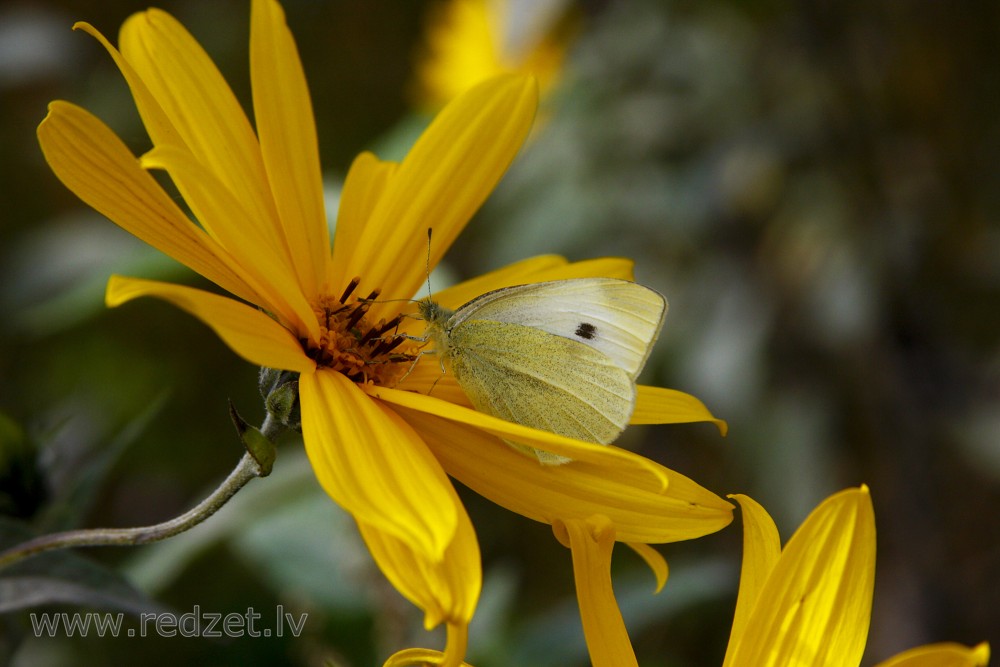Large white (Pieris brassicae)
Pieris brassicae, the large white, also called cabbage butterfly, cabbage white, cabbage moth (erroneously), or in India the large cabbage white, is a butterfly in the family Pieridae. It is a close relative of the small white, Pieris rapae.
The large white is common throughout Europe, North Africa and Asia.
Distribution
The large white is common throughout Europe, north Africa, and Asia to the Himalayas often in agricultural areas, meadows and parkland. It has managed to establish a population in South Africa and in 1995 it was predicted to spread to Australia and New Zealand.
The large white is a strong flier and the British population is reinforced in most years by migrations from the continent. Scattered reports of the large white from the north-eastern United States (New York, Rhode Island and Maine) over the past century are of a dubious nature and indicate either accidental transport or intentional release. Such introductions threaten to establish this agricultural pest in North America.
In 2010 the butterfly was found in Nelson, New Zealand where it is known as the great white butterfly. It is classed as an unwanted pest due to the potential effect on crops. For a limited period in October 2013 the Department of Conservation offered a monetary reward for the capture of the butterfly. After two weeks, the public had captured 134 butterflies, netting $10 for each one handed in. As a result of this and other containment measures, such as over 263,000 searches in the upper South Island and the release of predatory wasps, the large white was officially declared to be eradicated from New Zealand as of December 2014.
Morphology
Eggs
The large white eggs appear as a pale yellow colour. They turn into a darker yellow within twenty-four hours of being oviposited. A few hours prior to hatching, they will become black in colour, and the shell will become more transparent, and the larvae will appear visible.
Larvae
Large white larvae experience four moultings and five instars. The first instar follows hatching of the egg into large white larvae. The larvae are a light yellow in colour with distinctive brown heads and have soft bodies. The larvae appear as if they are very hairy. Following a moulting, the larvae enter the second instar. They have tubercles covered with black hair. In the third instar, large white larvae display more activity. This instar is when the larvae are observed to eat voraciously, and cause significant amounts of damage to their host plant. At this point, they are observed to be more yellow in colour, studded with black dots. Following the third instar, the larvae go through the fourth instar, with similar appearances as the larvae of the third instar, but with more aggrandized size and feeding behaviour. The large white larvae are observed to be cylindrical, robust, and elongated by the fifth instar, yellow in colour and with bright colouration on their abdomen and thorax. They are also observed to have a grey and black head. This instar requires maximum food quality and quantity in order to aid in full development, otherwise the larva dies before becoming an adult butterfly.
Adult
For both males and females, the wings are white with black tips on the forewings. The female also has two black spots on each forewing. The underside of each wing is a pale greenish and serves as excellent camouflage when at rest. The black markings are generally darker in the summer brood. The large white butterfly's wingspan reaches 5 to 6.5 cm on average.
Male
The upperside of the male is creamy white. The forewing is irrorated (sprinkled) with black scales at the base and along costa for a short distance. The apex and termen above vein 2 are more or less broadly black with the inner margin of the black area containing a regular even curve. In one or two specimens a small longitudinally narrow black spot was found in interspace 3. Hindwing: uniform, irrorated with black scales at base, a large black subcostal spot before the apex, and in a few specimens indications of black scaling on the termen anteriorly. The underside of the forewing is white, slightly irrorated with black scales at the base of cell and along costa. The apex is light ochraceous brown with a large black spot in outer half of interspace 1 and another quadrate black spot at base of interspace 3. The hindwing is light ochraceous brown, closely irrorated with minute black scales. The subcostal black spot before the apex shows through from the upperside. The antennae are black and white at apex. The head, thorax, and abdomen are black, with some white hairs, where underneath is whitish.
Female
The upperside of the female is similar to that of the male, but the irroration of black scales at the bases of the wings is more extended. The black area on apex and termen of forewing is broader, its inner margin less evenly curved. A conspicuous large, black spot also exists in the outer half of interspace 1 near the base of interspace 3. On the hindwing the subcostal black spot before the apex is much larger and more prominent. The underside is similar to that of the male but the apex of the forewing and the whole surface of the hindwing is a light ochraceous yellow, not ochraceous brown. The black discal spots on forewing are much larger. The antennae, head, thorax, and abdomen of the females are the same as for the male.
en.wikipedia.org
